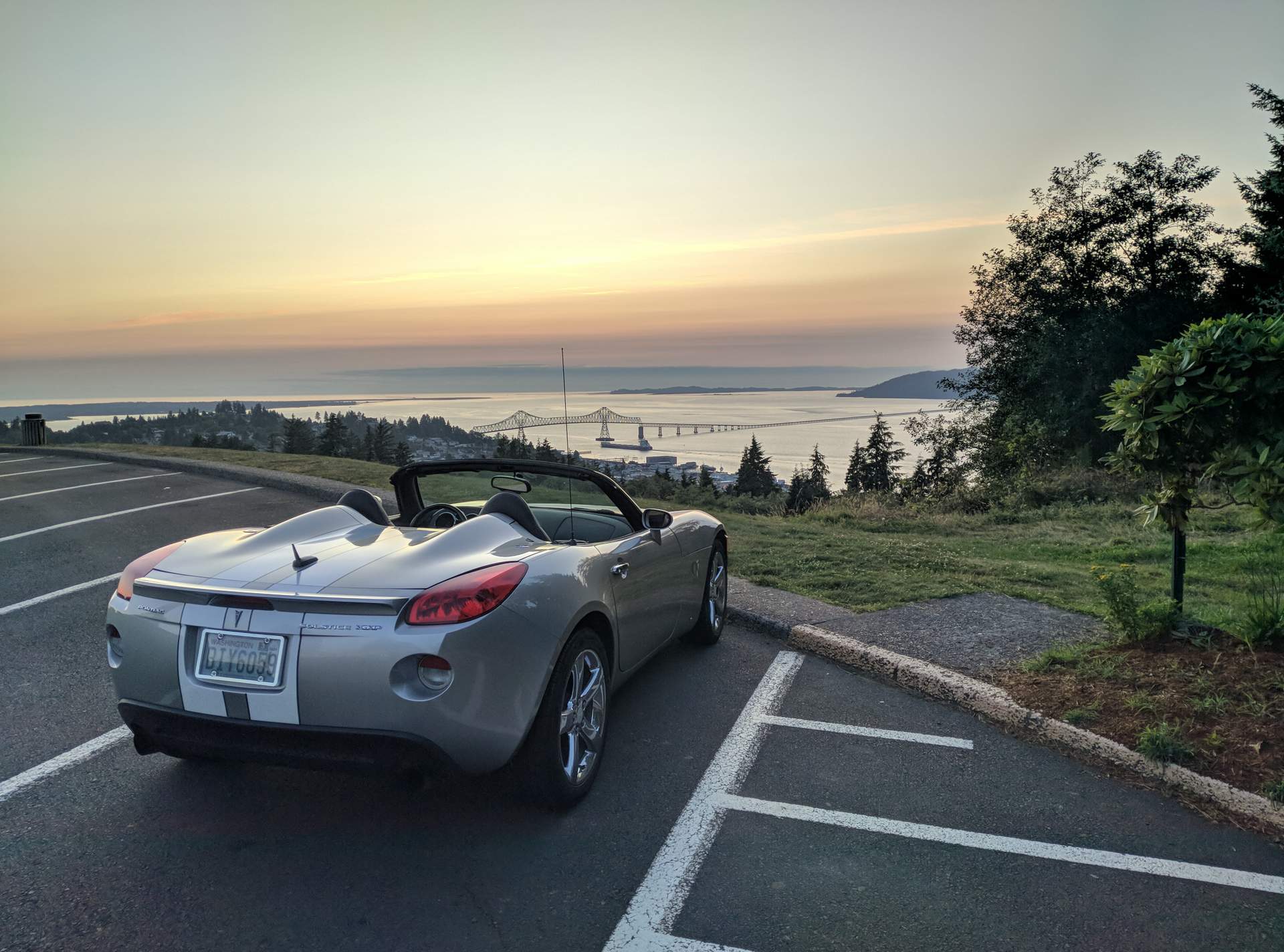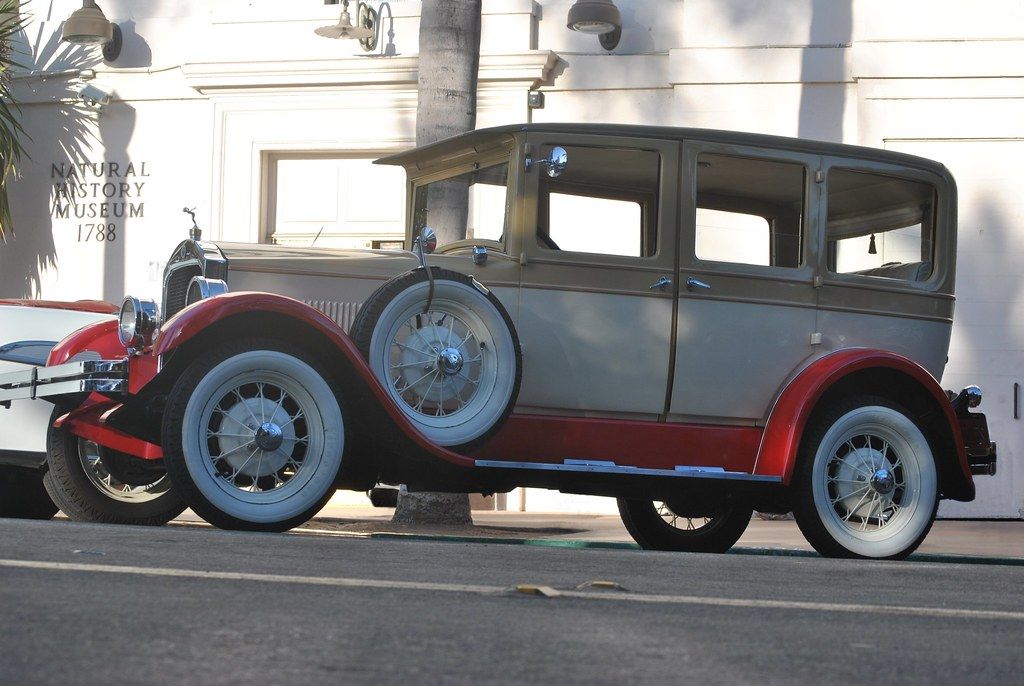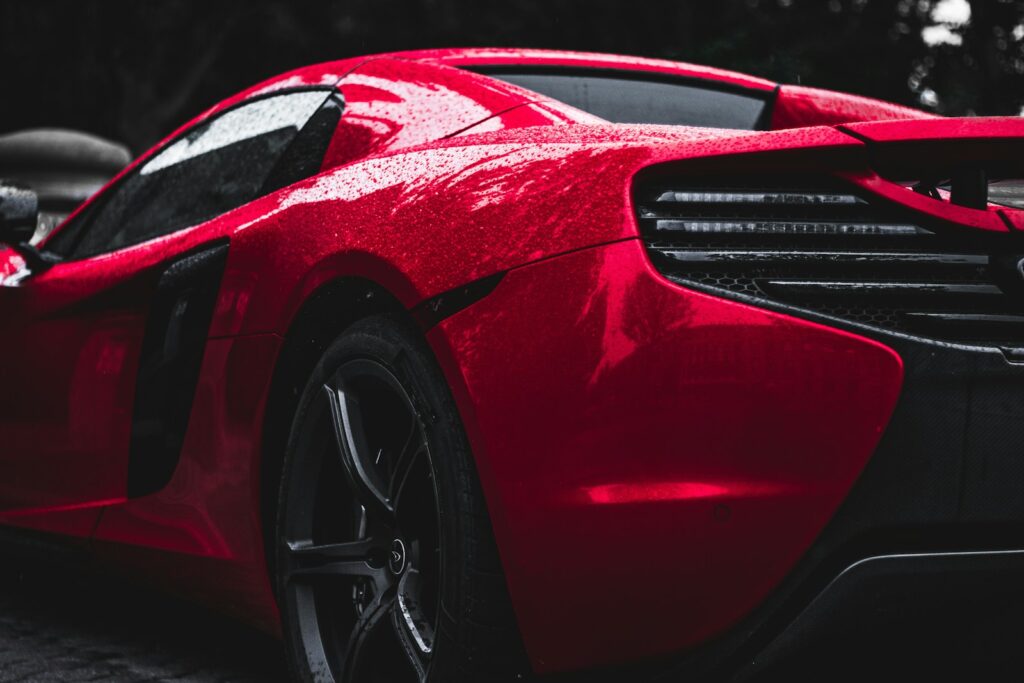
Alright, fellow pop culture fanatics and casual car enthusiasts, gather ’round! We’ve all seen those epic car chases, those sleek rides, or those quirky vehicles that steal every scene they’re in, right? Nothing says movie magic quite like a car that becomes an extension of its character, a silent (or roaring!) star in its own right.
But here’s the thing: not every legendary movie car rolled off the production line destined for greatness. Oh no. Hollywood, with its boundless imagination and the power of a killer script, has a knack for taking the seemingly mundane, the financially challenged, or even the downright awkward, and transforming them into absolute icons. It’s like a Cinderella story, but with more horsepower and fewer glass slippers.
So, buckle up! We’re about to take a super fun, super casual cruise down memory lane to celebrate the cars that truly hit the jackpot when they landed a starring role. These are the vehicles that were cool *only* because of the movies they were in, proving that sometimes, all you need is a little Tinseltown sparkle to go from overlooked to legendary.
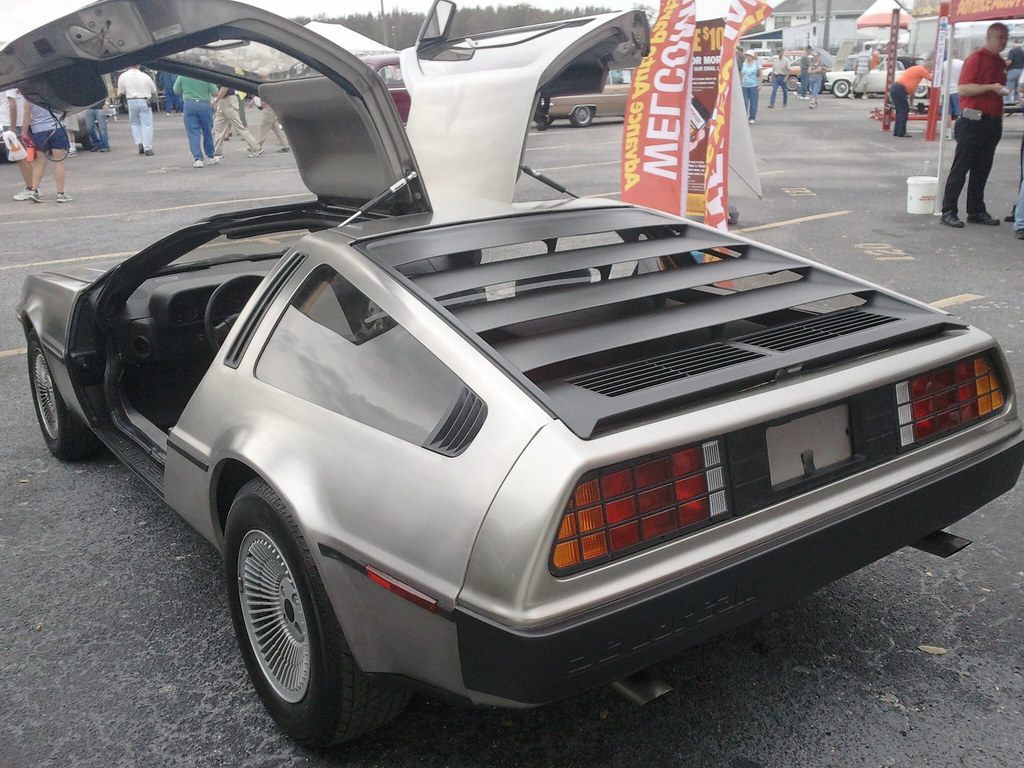
1. **The Time-Traveling Flop: 1981 DeLorean DMC-12 (Back to the Future)**When you picture the ultimate movie car, chances are the gleaming, gull-winged DeLorean from *Back to the Future* immediately springs to mind. It’s the quintessential time machine, synonymous with 80s sci-fi cool and Dr. Emmett Brown’s eccentric genius. Seriously, who hasn’t wished they could hit 88 mph and zip through the decades?
Here’s the kicker: the actual DeLorean DMC-12 wasn’t quite as magical as its outside appearance suggested. In the real world, this futuristic-looking ride, despite its revolutionary gull-wing doors and rebellious design, was actually a bit of a financial flop. It didn’t do too hot on the market, struggling to find its footing beyond its initial wow factor.
Yet, thanks to the genius of the *Back to the Future* franchise, the DeLorean DMC-12 was dramatically revived from its ill fate. The film immortalized it, turning what could have been a forgotten footnote in automotive history into the plutonium-powered (or, you know, lightning-powered) chariot of dreams. It became one of the most famous 80s movie cars, not because of its sales success, but entirely because of its role as a time-traveling hero.
It’s truly a testament to cinema’s power that a car that struggled so much in showrooms could become such a beloved icon. Every time we hear that unforgettable line, “You built a time machine… out of a DeLorean?” we’re reminded that sometimes, a car just needs the right movie to unlock its true, legendary coolness.
Car Model Information: 1981 Delorean DMC-12
Name: DMC DeLorean
Alt: 1983 DeLorean
Caption: 1983 DeLorean
Manufacturer: DeLorean Motor Company
Production: January 21, 1981 – December 1982
ModelYears: 1981–1983
Assembly: Dunmurry
Designer: Giorgetto Giugiaro
Class: Sports car
BodyStyle: coupé
Layout: Rear-engine, rear-wheel-drive layout
Doors: Gull-wing doors
Engine: 2.85 L
Abbr: on
Powerout: 130 hp
Transmission: 5-speed manual ,3-speed automatic
Wheelbase: 2413 mm
Length: 4267 mm
Width: 1988 mm
Height: 1140 mm
Weight: 1233 kg
Sp: us
Categories: 1980s cars, All Wikipedia articles written in American English, Articles with short description, Automobiles with backbone chassis, Automobiles with gull-wing doors
Summary: The DMC DeLorean is a rear-engine, two-seat sports car manufactured and marketed by John DeLorean’s DeLorean Motor Company (DMC) for the American market from 1981 until 1983—ultimately the only car brought to market by the fledgling company. The DeLorean is sometimes referred to by its internal DMC pre-production designation, DMC-12, although this was not used in sales or marketing materials for the production model.
Designed by Giorgetto Giugiaro, the DeLorean is noted for its gull-wing doors and brushed stainless-steel outer body panels, as well as its lack of power and performance. Though its production was short-lived, the DeLorean became widely known after it was featured as the time machine in the Back to the Future films.
With the first production car completed on January 21, 1981, the design incorporated numerous minor revisions to the hood, wheels and interior before production ended in late December 1982, shortly after DMC filed for bankruptcy and after total production reached an estimated 9,000 units.
Despite the car having a reputation for poor build quality and an unsatisfactory driving experience, the DeLorean continues to have a strong following, driven in part by the popularity of Back to the Future. 6,500 DeLoreans were estimated to still be on the road as of 2015.
Get more information about: DMC DeLorean
Buying a high-performing used car >>>
Brand: DeLorean Model: DMC-12
Price: $56,500 Mileage: 0 mi.
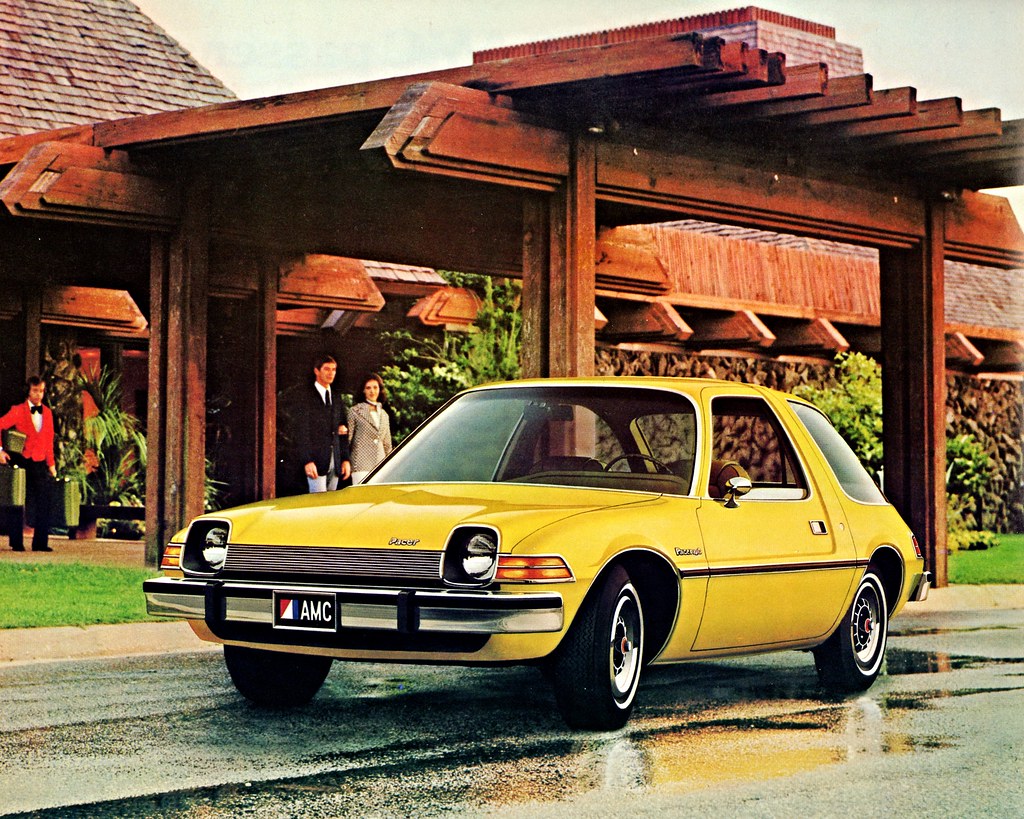
2. **The Unlikely Rock Star: Mirthmobile, 1976 AMC Pacer (Wayne’s World)**If you’re a fan of hilarious slacker comedy, then you undoubtedly know the Mirthmobile. This weirdly wide, light-blue 1976 AMC Pacer, complete with flames and a licorice dispenser, is as iconic as Wayne and Garth themselves. It’s the perfect rolling sanctuary for headbanging to Queen’s ‘Bohemian Rhapsody’ with your best buds.
Now, let’s be real for a second: the AMC Pacer wasn’t exactly a looker. The context itself hints at this, calling it “the least attractive” out of all the famous movie cars. Its unconventional, almost bubble-like design and unusual width made it quite a departure from conventional automotive aesthetics of its time.
But here’s where the magic of *Wayne’s World* comes in. What might have been considered an awkward, perhaps even ugly car, became one of the “most excellent and coolest movie cars” precisely because it was the perfect fit for the Wayne’s World duo. Its distinct, almost goofy appearance was exactly what made it endearing and memorable, embodying the film’s playful and irreverent spirit.
The Mirthmobile didn’t just become famous; it became a symbol of friendship, rock ‘n’ roll, and living life on your own terms. It proved that a car doesn’t need to be sleek or powerful to be cool; sometimes, it just needs to be the backdrop for unforgettable, headbanging moments with your best friends. Party on, Garth!

3. **From Junkyard Relic to Ghost-Busting Legend: Ectomobile, 1959 Cadillac Miller-Meteor (Ghostbusters)**Who you gonna call when you see a spectral apparition? The Ghostbusters, of course! And how do they arrive? In the instantly recognizable, siren-blaring, proton pack-equipped Ectomobile, a glorious 1959 Cadillac Miller-Meteor that screams ‘supernatural emergency services.’ This car is a bona fide legend, almost as famous as the ghost-busting team itself.
Despite its impressive transformation and V8 engine churning out 325 hp, the Ectomobile wasn’t exactly a high-performance machine. The context notes its “floaty suspension and curb-weight design crippled its performance.” Car enthusiasts, in fact, had a “double-edged sword” view of its appeal, acknowledging its inherent quirks.
Yet, none of that matters when you’re hurtling through the streets of New York, sirens wailing, ready to tackle a rogue Slimer. The film *Ghostbusters* gave this once-unassuming Cadillac a personality, a purpose, and a place in cinematic history, proving that even a clunky, repurposed vehicle can become an unforgettable hero when given the right role.

4. **The Lovable Underdog: Herbie, 1963 Volkswagen Beetle (Herbie: Fully Loaded)**Ah, Herbie! The little white Volkswagen Beetle with a mind of its own, a champion racer with a big heart. This car has charmed generations, becoming a symbol of determination, pluck, and the unexpected capabilities of an underdog. You just can’t help but root for Herbie!
It’s fascinating to think that the context explicitly refers to the Beetle as an “eyesore” before its cinematic fame. Introduced in 1938 as a “small people’s vehicle,” its toy-like appearance might not have screamed ‘cool’ to everyone. While its popularity did soar after World War II, it was the magic of the *Herbie* series that truly turned this humble car into a beloved character.
The *Herbie* movies imbued the 1963 Volkswagen Beetle with a unique, “scamp-like and go-getting character” that won the hearts of audiences across the globe. It wasn’t just a car; it was a friend, a competitor, and a loyal companion. This anthropomorphic portrayal completely transcended its original design, making it an icon.
By dint of Herbie’s lovable antics and on-screen triumphs, Beetles from the early ’60s became strong collector’s items. People weren’t just buying a car; they were buying a piece of that joyful, determined spirit that Herbie embodied. This is a classic case of a car whose ultimate coolness and desirability were purely a product of its cinematic personality.
Car Model Information: 1969 Volkswagen Beetle (Pre-1980) Base
Sp: uk
Name: Volkswagen Type 1,”Beetle”
Caption: 1965–1966 Volkswagen Käfer
Manufacturer: Volkswagen
Alt: A front-three quarters view of a pale-yellow Volkswagen Käfer. It features 165/80R15 tires, which shod 15×4. 5″ silver, circular wheels. The Käfer features a beetle-like body, and its window is open. The picture is taken with much greenery in the background, and the photo was edited to give it a more warmer tone.
Aka: List of names for the Volkswagen Type 1
Assembly: #Markets and assembly
Designer: Ferdinand Porsche
Class: Small family car
BodyStyle: Sedan (automobile),convertible
Production: 1938–2003,21,529,464 produced
Successor: Volkswagen Golf Mk1,Volkswagen Gol#First generation (Typ30, 1980),Volkswagen New Beetle
Layout: Rear-engine, rear-wheel-drive layout
Engine: Petrol,Volkswagen air-cooled engine,1192 cc H4,1285 cc H4,1493 cc H4,1584 cc H4
Transmission: manual transmission,Saxomat,Autostick
Wheelbase: convert
Length: convert
Width: convert
Height: 1500 mm
Abbr: on
Weight: convert
Categories: 1940s cars, 1950s cars, 1960s cars, 1970s cars, 1980s cars
Summary: The Volkswagen Beetle, officially the Volkswagen Type 1, is a small family car produced by the German company Volkswagen from 1938 to 2003. A global cultural icon known for its bug-like design, the Beetle is widely regarded as one of the most influential cars of the 20th century. Its production period of 65 years is the longest for any single generation of automobile, and its total production of 21.5 million units makes it the most produced car of a single platform in history and the second-highest of all nameplates manufactured in the 20th century.
The Beetle was conceived in the early 1930s. The leader of Nazi Germany, Adolf Hitler, decided there was a need for a people’s car—an inexpensive, simple, mass-produced car—to serve Germany’s new road network, the Reichsautobahn. The German engineer Ferdinand Porsche and his design team began developing and designing the car in the early 1930s, but the fundamental design concept can be attributed to Béla Barényi in 1925, predating Porsche’s claims by almost ten years. The result was the Volkswagen Type 1 and the introduction of the Volkswagen brand. Volkswagen initially slated production for the late 1930s, but the outbreak of war in 1939 meant that production was delayed until the war had ended. The car was originally called the Volkswagen Type 1 and marketed simply as the Volkswagen. It was not until 1968 that it was officially named the “Beetle”.
Volkswagen implemented designations for the Beetle in the 1960s, including 1200, 1300, 1500, 1600, 1302, and 1303. Volkswagen introduced a series of large luxury models throughout the 1960s and 1970s—comprising the Type 3, Type 4 and K70—to supplement the Beetle, but none of these models achieved the level of success that it did. In 1972, it became the best-selling car of all time, a position it retained for nearly three decades. Rapidly changing consumer preferences toward front-wheel drive compact hatchbacks in Europe prompted Volkswagen’s gradual shift away from rear-wheel drive, starting with the Golf in 1974. In the late 1970s and ’80s, Japanese automakers dominated some markets around the world, which contributed to the Beetle’s declining popularity.
The Beetle remains one of the best-selling cars of all time and is the first to sell over 20 million units. Over its lifespan, its design remained consistent, yet Volkswagen implemented over 78,000 incremental updates. These modifications were often subtle, involving minor alterations to its exterior, interior, colours, and lighting. Some more noteworthy changes included the introduction of new engines, models and systems, such as improved technology or comfort. The Beetle maintains a substantial cultural influence and is regarded as one of the most iconic vehicles in automotive history; its success largely influenced the way automobiles are designed and marketed, and propelled Volkswagen’s introduction of a Golf-based series of vehicles.
Get more information about: Volkswagen Beetle
Buying a high-performing used car >>>
Brand: Volkswagen Model: Beetle
Price: $39,950 Mileage: 43,823 mi.
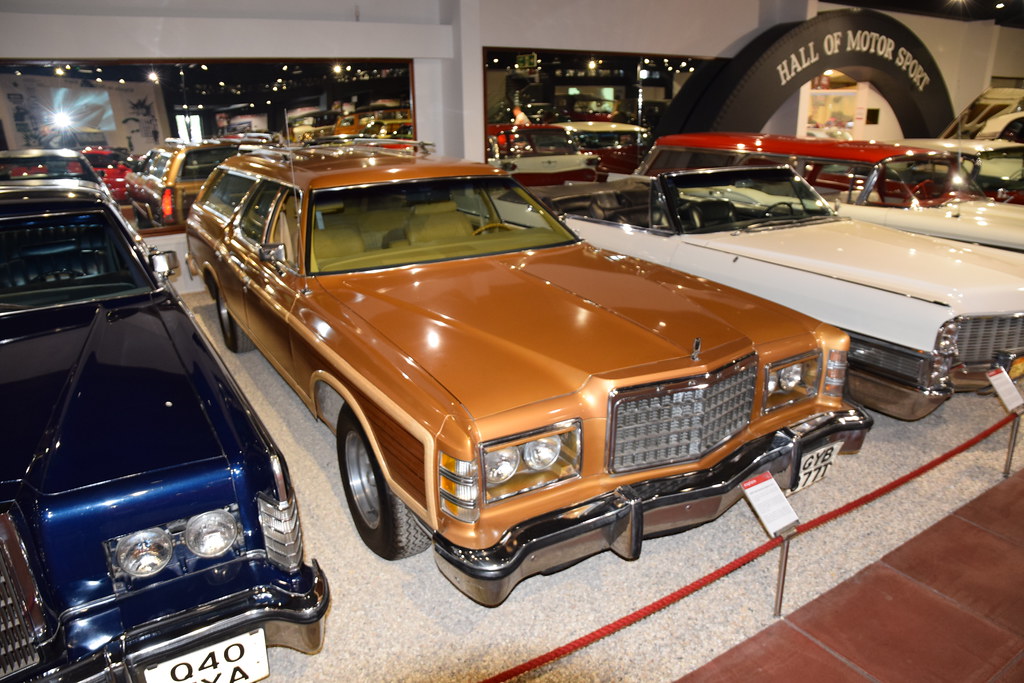
5. **The Unforgettable Family Vacation Nightmare: 1979 Ford LTD Country Squire (National Lampoon’s Vacation)**Every family road trip has its share of memorable moments, but none quite compare to the Griswolds’ cross-country odyssey in the Wagon Queen Family Truckster from *National Lampoon’s Vacation*. This monstrous, customized 1979 Ford LTD Country Squire, with its multiple headlights and garish faux wood paneling, is the stuff of legendary comedic nightmares.
The context doesn’t shy away from describing this beast as “a bit of an eyesore,” and let’s be honest, it was designed to be! It was the epitome of an uncool, over-the-top family station wagon, chosen specifically for its comedic potential. While it “got the job done” for Clark Griswold and his clan, its true fame came from how utterly ridiculous it looked.
Through the Griswolds’ endless stream of mishaps, indignities, and sheer bad luck, this otherwise unremarkable station wagon was transformed into a comedy legend. Its exaggerated design perfectly complemented the film’s humor, making it an iconic representation of the disastrous, yet strangely relatable, family vacation.
The movie took a mundane, somewhat unappealing vehicle and turned it into an enduring symbol of American road trip woes and the lengths a father will go to for his family. The Truckster’s uncoolness, amplified by the film, became its defining, unforgettable characteristic, securing its spot in cinematic history and in our hearts.
Car Model Information: 2023 Mazda Mazda3 FWD w/Select Package
Caption: 1988–1989 Ford LTD Country Squire
Name: Ford Country Squire
Manufacturer: Ford Motor Company
Class: Full-size,station wagon
BodyStyle: station wagon
ModelYears: 1950–1991
Predecessor: 1941 Ford#1948
Related: Mercury Colony Park,Ford Country Sedan,Ford Ranch Wagon
Categories: 1960s cars, 1970s cars, 1980s cars, 1990s cars, All articles with dead external links
Summary: The Ford Country Squire is a series of full-size station wagons that were assembled by American automaker Ford. Positioned as the top-level station wagon of the Ford division, the Country Squire was distinguished by woodgrain bodyside trim. From 1950 through the 1991 model years, eight generations of the Country Squire were produced. Following the discontinuation of Edsel Bermuda, Mercury marketed the Mercury Colony Park as a divisional counterpart of the Country Squire, sharing bodywork and trim while the Mercury was not available with a six cylinder engine and was more expensive due to the optional equipment on the Ford that was standard on the Mercury.
As part of the full-size Ford model range, the Country Squire was the top trim package station wagon counterpart of several model lines. For its first two generations, the Country Squire was based upon the Ford Custom Deluxe and the Ford Crestline that replaced it, along with the more modestly equipped Ford Country Sedan which was identical in dimensions except for the woodgrain appearance and minimal standard equipment. For its next three generations, the Country Squire was a distinct model range; initially sharing its trim with the Ford Fairlane, the Country Squire later adopted trim of the Ford Galaxie. For its final two generations, the Country Squire became a counterpart of Ford LTD and the Ford LTD Crown Victoria after its downsizing for the last generation, while sharing multiple passenger accommodation duties with the Ford Aerostar.
The Country Squire was discontinued as part of the development of the 1992 Ford Crown Victoria and passenger carrying duties were given to the Ford Windstar. The decline in full-size station wagon sales meant the Crown Victoria was exclusively a four-door sedan. The 41-year production run of the Country Squire is the third-longest of a Ford car nameplate in North America, surpassed only by the Ford Thunderbird and Ford Mustang which is to date still in production.
The term squire is a British term that refers to a village leader or a lord of the manor, which is also called a “squire”, and the term was applied to members of the landed gentry.
Get more information about: Ford Country Squire
Buying a high-performing used car >>>
Brand: Ford Model: LTD Country Squire
Price: $17,921 Mileage: 57,854 mi.

6. **The Submarine Sports Car: 1976 Lotus Esprit Series I (The Spy Who Loved Me)**From land to sea, our next stop in movie car greatness takes us under the waves with another legendary Bond vehicle: the 1976 Lotus Esprit Series I from *The Spy Who Loved Me*. Usually, driving your car into the ocean is a pretty bad plan, right? Not for 007! This isn’t just a car; it’s a full-blown submarine, making a splash (pun intended) in the annals of cinematic transportation.
The context vividly describes how Bond “handles it just fine, driving the iconic Series I Esprit that somehow transforms into a submarine.” This unbelievable transformation earned the car an unforgettable nickname: “Wet Nellie.” It was a marvel of cinematic engineering, turning a stylish sports car into a fully functional underwater vehicle, perfect for those deep-sea escapes from villainous henchmen.
The impact of this Lotus Esprit was far-reaching. It not only became a pop culture icon – with the “car used in the underwater scenes” even being “bought by businessman Elon Musk in September 2013” – but it also propelled Lotus onto a new stage. Thanks to the Esprit, “Lotus entered the modern supercar market for the first time,” solidifying its reputation for innovative and striking designs.
With its “exotic shape,” “sharp angles and a wedge shape,” and “crisp edges and modern looking” aesthetics, the Esprit was a showstopper even before its aquatic abilities were revealed. Its extended production run from 1976 to 2004 speaks volumes about its enduring appeal. The Lotus Esprit Series I truly is a testament to how “fantastical functions” can elevate a car to legendary status, making us all wish our daily drivers could pull off such an oceanic feat.
Car Model Information: 2023 Mazda Mazda3 FWD w/Select Package
Name: Lotus Esprit
Caption: 1999 Lotus Esprit V8
Manufacturer: Lotus Cars
Production: 1976–2004,10,675 produced
Assembly: Hethel,Norfolk,England
Class: Sports car
BodyStyle: coupé
Layout: Longitudinal engine,Rear mid-engine, rear-wheel-drive layout
Sp: uk
Predecessor: Lotus Europa
Successor: Lotus Europa S
Categories: 1980s cars, 1990s cars, 2000s cars, 24 Hours of Le Mans race cars, All articles with unsourced statements
Summary: The Lotus Esprit is a sports car built by Lotus Cars from 1976 to 2004 at their Hethel, England factory. It has a rear mid-engine, rear-wheel-drive layout. Together with the Lotus Elise / Exige, it is one of Lotus’ most long-lived models.
The Esprit was among the first of the (near) straight-lined, hard-edge creased, and sometimes wedge-shaped, polygonal “folded paper” designs of the prolific, and highly successful Italian industrial and automotive designer Giorgetto Giugiaro. The Esprit’s backbone chassis was later adapted to carry the body of the DeLorean car, another low-bodied, Giugiaro-drawn, sharp-creased, wedge-shaped sportscar design. In 1978, the first updates led to the series 2 and 2.2 L (134 cu in) engined Esprit S2.2, made until the 1982–1988 Series 3 and Turbo Esprit models, that used a 1980 Giugiaro designed aerodynamic and aesthetic restyling package.
The Lotus Esprit however, lived on through the 1990s, and into the 2000s. It received its first significant restyling by designer Peter Stevens, who also did styling on the McLaren F1. Stevens gave the Esprit overall softer lines and shapes, but the car did not get a new series number – it is instead often just called the ‘Stevens Esprit’, or by its project number, the X180, made from 1988 to 1994.
In 1994, an official Series 4 Esprit, drawn by designer Julian Thomson, had a further rounded shape, especially the bumper sections and lower body of the car. Styling-wise, this became the most long-lived Esprit (1994–2004), only receiving its last changes, by Russell Carr in 2002.
Over the years, the performance of the Esprit’s 4-cylinder engine was increased from around 150 PS (148 hp; 110 kW) and just under 200 N⋅m (148 lb⋅ft) of torque, to double those power figures, mainly through greater inlet and exhaust flow, and strong turbo-charging. And from 1996, a new 3.5 L (214 cu in) V8 twin-turbo engine was added, offering 355 PS (350 hp; 261 kW). Contrary to a long list of low-volume British (sports) cars, with the 3.5 l Rover V8 engine, the Esprit received a Lotus in-house designed V8. Top speed rose from some 214 km/h (133 mph) in 1976, to over 280 km/h (174 mph) for the V8, twenty years later.
After a 28-year production run, the Esprit was one of the last cars made with pop-up headlights, together with the 5th generation Chevrolet Corvette.
Get more information about: Lotus Esprit
Buying a high-performing used car >>>
Brand: Lotus Model: Esprit Series I
Price: $17,921 Mileage: 57,854 mi.
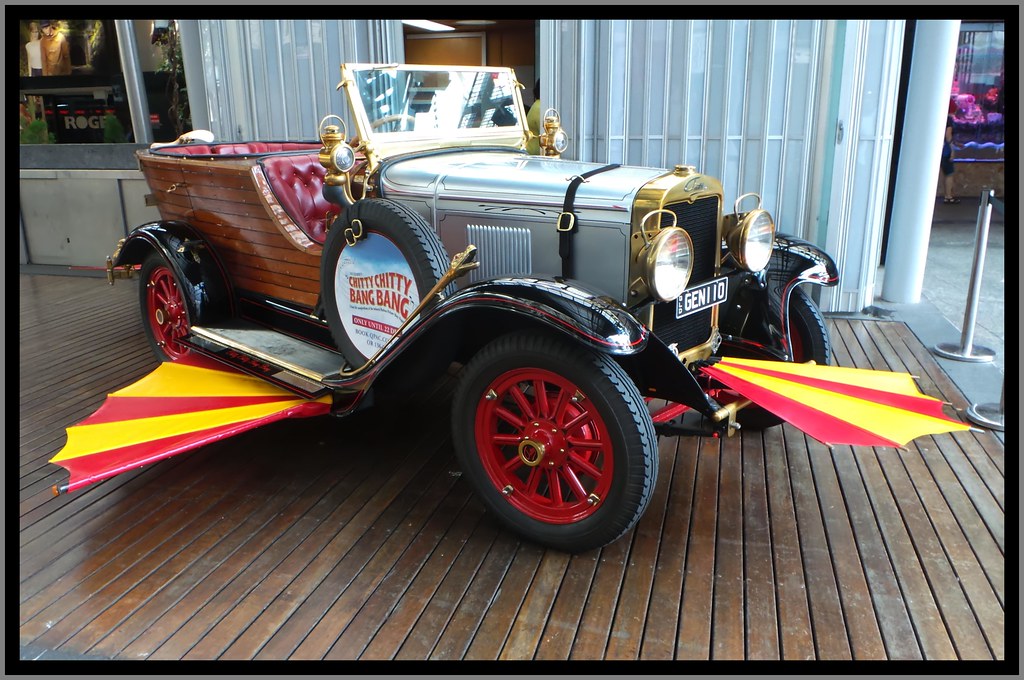
7. **The Truly Magical Machine: Chitty Chitty Bang Bang (Chitty Chitty Bang Bang)**Prepare for a whimsical journey with our next entry, a car so magical it practically floats off the screen and into your imagination: Chitty Chitty Bang Bang! This isn’t just a vehicle; it’s a character in itself, full of charm, wonder, and abilities that defy the laws of physics. It’s hands down one of the “coolest movie cars” to ever grace the silver screen.
The inspiration behind this fantastical car is almost as charming as the movie itself. Writer Ian Fleming, yes, *that* Ian Fleming, “took his inspiration for the car from a series of aero-engined racing cars built by Count Louis Zborowski in the early 1920s.” These original “Chitty” cars were “oddly long shaped,” a hint at the unique design of the cinematic version which was later “brought from a junkyard, restored, and destroyed in an automobile accident during a race.” Quite a backstory!
But the movie version, based on Fleming’s novel, truly gave Chitty its unforgettable persona. This car could do it all: it “could fly, float and drive on the road like a normal car.” Imagine the sheer joy and limitless possibilities! It blended steampunk aesthetics with pure, childlike fantasy, making it a dream machine for anyone who watched the film.
Chitty Chitty Bang Bang is a quintessential example of a car becoming an indelible part of pop culture through its “fantastical functions.” It embodies adventure, ingenuity, and the power of imagination, making it a beloved icon that reminds us that sometimes, cars don’t just take us places; they take us on extraordinary, magical adventures.
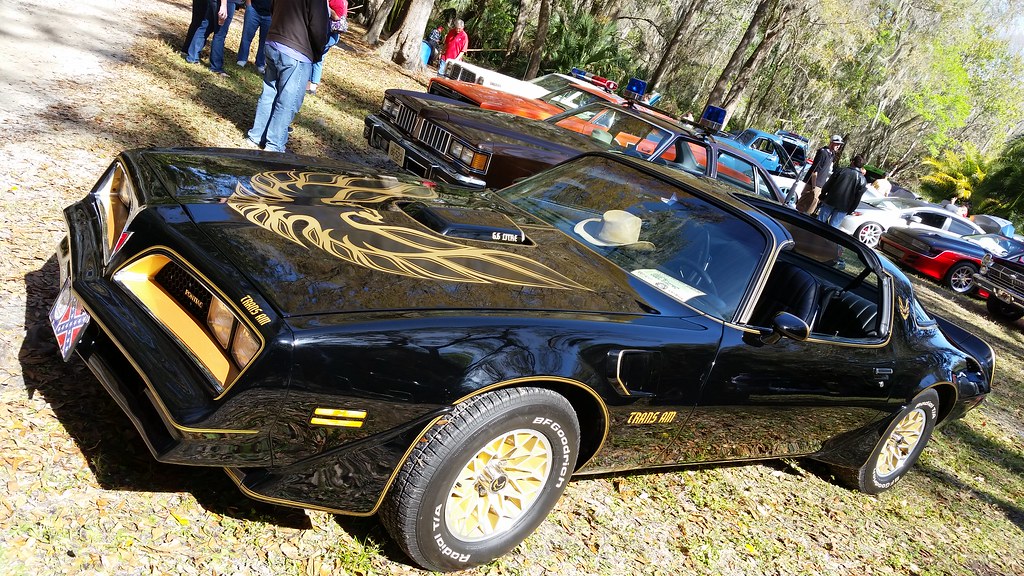
8. **The King of Cool: 1977 Pontiac Trans Am (Smokey and the Bandit)**Shift your gears, folks, because we’re about to peel out with a car that’s synonymous with cool, speed, and a whole lot of mischief: the 1977 Pontiac Trans Am from *Smokey and the Bandit*. This black beauty isn’t just a car; it’s a co-star alongside Burt Reynolds, forever roaring its way into our hearts and becoming “arguably the most iconic Pontiac Firebird in history.”
The film itself, a “sleeper hit,” exploded onto the scene in 1977, grossing “$126.7 million” and becoming “the second-highest-grossing movie of 1977 after Star Wars.” The Trans Am was absolutely central to this success. The context notes that “the legacy of the Trans Am can be marked by the steep jump in sales after the film’s release.” That’s the power of cinema, turning a car into a must-have!
Why was it such a hit? Well, “Burt Reynolds’ appeal or the Special Edition paint job” certainly played a part, alongside its distinctive T-top. The car, described as a “high-performance package for the Firebird, Pontiac’s take on the Camaro,” exuded a rebellious, take-on-the-world attitude that perfectly matched the film’s bootlegging antics. It made everyone want to be a bandit, even for a day.
The 1977 Pontiac Trans Am isn’t just a fast car; it’s a symbol of freedom, rebellion, and pure, unadulterated fun, all wrapped up in that iconic black and gold package. It proved that a car could embody an entire era and a whole vibe, becoming an “unforgettable moment” generator and a true pop culture legend thanks to its leading role.
Car Model Information: 2023 Mazda Mazda3 FWD w/Select Package
Name: Pontiac Firebird
Caption: The second, third, and fourth generations of,the Pontiac Firebird Trans Am
Manufacturer: Pontiac (automobile)
Production: February 23, 1967 – August 30, 2002
ModelYears: 1967 – 2002
Class: Pony car,Muscle car
Platform: GM F platform
Related: Chevrolet Camaro
Layout: Front engine, rear-wheel-drive layout
Categories: 1970s cars, 1980s cars, 1990s cars, 2000s cars, All articles with dead external links
Summary: The Pontiac Firebird is an American automobile built and produced by Pontiac from the 1967 to 2002 model years. Designed as a pony car to compete with the Ford Mustang, it was introduced on February 23, 1967, five months after GM’s Chevrolet division’s platform-sharing Camaro. This also coincided with the release of the 1967 Mercury Cougar, Ford’s upscale, platform-sharing version of the Mustang.
The name “Firebird” was also previously used by GM for the General Motors Firebird series of concept cars in the 1950s.
Get more information about: Pontiac Firebird
Buying a high-performing used car >>>
Brand: Pontiac Model: Trans Am
Price: $17,921 Mileage: 57,854 mi.


